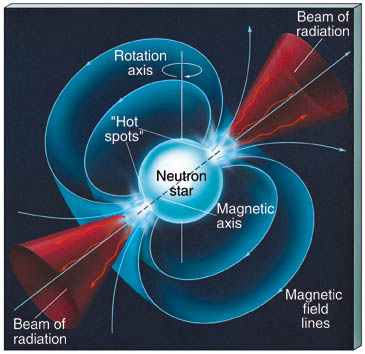Main sequence star with mass 8 to 25 times the mass of solar mass becomes supernova type II after losing envelop, leaving a dense degenerate neutron core behind. This core is called neutron star. Neutron stars collapse from larger stars. During the collapse, angular momentum must be conserved. Therefore the degenerate dense neutron star rotates very rapidly, typically about 1,000 times per second. They also have large magnetic field, due to the collapse and compression of the original magnetic field of the star.
Thus, neutron star possesses two different axes – one is for angular momentum conservation and another is for stored magnetic field. However, star rotates about its rotation axes. If magnetic axis is not aligned with the rotation axis, then the star is called Pulsar. Thus, pulsars are spinning neutron stars with magnetic field axis not aligned with the rotation axis. Pulsars emits relativistic spiraling charge particles along the magnetic axis. This ejection is because of the so called ‘not connected magnetic lines’, like in solar flares. In the process of ejection, relativistic charged particles emits electromagnetic radiation.
This radiation can be resolved if one of the poles is pointed towards us. This radiation is usually in radio band. When neither pole is pointed towards us, we don’t detect it.
radiation is usually in radio band. When neither pole is pointed towards us, we don’t detect it.
The spinning of the pulsar slows over time. It takes about 30 million years for the rotation to slow down from 0.001 seconds to 2 seconds. However, no pulsars having period greater than 5 seconds has been observed till date. It was expected because of the age of the universe. It is believed that there must be unknown shut off mechanism for the charged particles as the star slows its spinning.
Let’s suppose you are standing on a neutron star having radius 10 km and rotation rate of 0.001 seconds. How fast would you be traveling in Km/s? How does this compared with the speed of light?
A rotation rate of 0.001 seconds mean that you are traveling around an entire circle of radius 10 km in only 0.001 seconds. The circumference of a circle is
So, you travel 62.8 km in 0.001 seconds, that is about 62800 km/s. Thus, you can travel with 20% of the speed of light.





